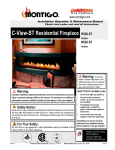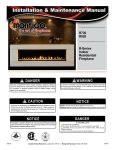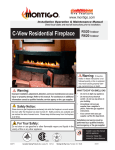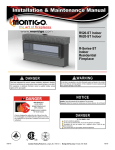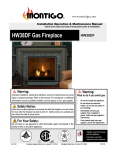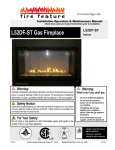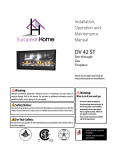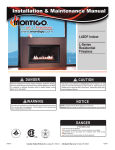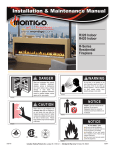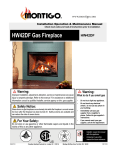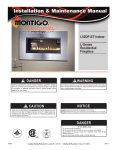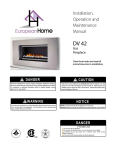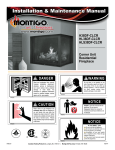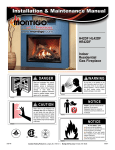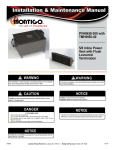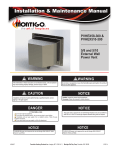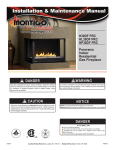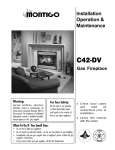Download Montigo R620 Specifications
Transcript
Installation & Maintenance Manual R520 R620 R-Series Indoor Residential Fireplace WARNING DANGER Read and understand this manual. Improper installation, adjustment, alteration, service or maintenance can cause serious injury, property damage or even death. For assistance or additional information consult a qualified installer, service agency or the gas supplier. Do not store or use gasoline or any other flammable vapors and liquids in the vicinity of this or any other gas burning appliance. A fire or explosion my occur causing serious injury, property damage or even death. CAUTION Glass doors on gas fireplaces are extremely hot while the fireplace is on and remain hot even after the fireplace has been turned off. Safety screens are available and can reduce the risks of severe burns. Please keep children away from the fireplace at all times. NOTICE Installer: Leave this manual with the appliance. Do not remove. Consumer: Retain this manual for maintenance and future reference. Do not Discard. DANGER Blank IF YOU SMELL GAS Do not try to light any appliance. Do not touch any electrical switch; do not use any phone in your building. Immediately call your gas supplier from a neighbor's phone. Follow the gas supplier's instructions. If you cannot reach your gas supplier, call the fire department. Blank Flammable materials ® C US Toxic Corrosive Danger overhead crane Blank Flammable materials Explosion risk Toxic Corrosive Danger overhead crane Fork lift trucks High voltage General Warning Laser Radiation Biohazard Oxidising Hot surface Danger of entrapment Danger of death Fork lift trucks High voltage Flammable materials Explosion risk Toxic Corrosive Danger overhead crane Fork lift trucks General Warning Laser Radiation Biohazard Oxidising Hot surface Danger of entrapment Danger of death Irritant Slippery floor Watch your step Cutting High temperatures Glass hazard Danger of suffocation Hot surface High voltage Blank General Warning Laser Radiation Biohazard Danger of entrapment Danger of death Irritant Slippery floor Watch your step Cutting High temperatures Glass hazard Danger of suffocation Gas bottles Watch for falling objects Explosion risk Electricity Danger for cutter Entrapment hazard Battery hazard Rotating parts Corrosive Danger overhead crane Flammable materials Toxic Oxidising Fork lift trucks High voltage Glass hazard Danger of suffocation Irritant Slippery floor Watch your step Cutting High temperatures Gas bottles Watch for falling objectsfield Strong magnetic Electricity Danger for cutter Entrapment hazard Battery hazard Rotating parts Low temperature Optical radiation Laser Radiation Biohazard Non ionizing radiation Oxidising Radiation General Warning Hot surface Hazardous to the Environment Danger of entrapment Danger of harming your hands Danger of death Gas bottles Watch for falling objects Strong magnetic field Electricity Danger for cutter Optical radiation Entrapment hazard Battery hazard Non ionizing radiation Radiation Hazardous to the Environment Danger of harming your hands Irritant Slippery floor Watch your step Cutting High temperatures Glass hazard Danger of suffocation Low temperature Strong magnetic field Optical radiation Non ionizing radiation Radiation Hazardous to the Environment Danger of harming your hands Gas bottles Watch for falling objects Electricity Danger for cutter Entrapment hazard Battery hazard Rotating parts Low temperature XG0771 Explosion risk Rotating parts Canadian Heating Products Inc. Langley, BC V4W 4A1 | Montigo Del Ray Corp. Ferndale, WA 98248 040513 R520 & R620 Power Vent Indoor Gas Fireplace Table of Contents Safety Alert Key....................................................................................... 3 Introduction .......................................................................................... 3 Congratulations on your purchase............................................................... 3 Warranty and Installation Information: (See Appendix B)........................... 3 Installation .......................................................................................... 4 Section A: Before You Begin ....................................................................... 4 Important Message.................................................................................. 4 Before you start........................................................................................ 4 Pre-Installation Checklist......................................................................... 4 Introduction to R-Series Fireplace........................................................... 5 Section 1: Product Dimensions...............................................................6 - 7 R520* dimensions.................................................................................... 6 R620* dimensions.................................................................................... 7 Section 2: Framing.................................................................................8 - 12 Clearances ....................................................................................... 8 Raised Installation............................................................................9 - 11 Installing the Fireplace......................................................................10 Installing the Back Frame................................................................. 11 Recessed Installation............................................................................12 Section 3: Venting................................................................................13 - 24 Section 5: Installing the Gas Line....................................................................27 Fuel Consumption......................................................................................27 Pressure requirements:..............................................................................27 Gas Connection ........................................................................................27 Section 6: Testing the System.........................................................................28 Section 7: Finishing ................................................................................29 - 30 Installation Of Cement Board.....................................................................29 Installing Gyproc/Drywall............................................................................29 Finishing Around the Fireplace...................................................................30 Mantels & Surrounds..................................................................................30 Section 8: Removing & Installing the Door ...................................................31 Section 9: Installing the Firestones ...............................................................32 Operation ........................................................................................33 Start-up Sequence ........................................................................................33 Maintenance ........................................................................................34 Appendix .................................................................................35 - 38 Appendix A: Power Vent Locations.........................................................35 - 36 Appendix B: Warranty.....................................................................................37 Appendix C: State of Massachusetts.............................................................38 Notes for Planning Venting....................................................................13 Section 3 -1 Converting to Rear Vent......................................................13 Section 3 -1- 1 Converting the Flue........................................................13 Section 3-1-2 Converting Pressure Sensing Tub & Air Baffle...............14 Section 3 -2 Installing a Roof Mounted Vent System.......................15 - 16 Section 3 -2-1 Installing Roof Mounted Power Vent & Rough-in Frame... Section 3 -3 Installing a Wall Mounted Vent System........................19 - 20 Section 3 -3-1 Installing Roof Mounted Power Vent & Rough-in Frame... .................................................................................17 - 18 .................................................................................21 - 22 Section 3 -4 Venting Components.............................................................23 Section 3 -5 Heat Shields........................................................................... 24 Section 4: Wiring .................................................................................25 - 26 Installing the Fireplace Control Box......................................................25 Installation of Electrical Supply..............................................................25 Installing the Remote Switch.................................................................25 Wiring Diagram......................................................................................26 Conduit & Wiring Clearances................................................................26 Page 2 XG0771 - 040513 R520 & R620 Power Vent Indoor Gas Fireplace Safety Alert Key Introduction This manual covers installation, operation and maintenance. Lighting, operation and care of this fireplace can be easily performed by the homeowner. All installation and service work should be performed by a qualified or licensed installer, plumber or gas fitter as certified by the state, province, region or governing body where the fireplace is being installed. R520N-I X R520L-I R620N-I R620L-I Linear Burner w/ Glass Accessories Honeywell Hot Surface Ignition We strongly encourage you to read and carefully follow the instructions laid out in this Installation, Operation and Maintenance Manual and retain it for your future reference. Pay special attention to all cautions, warnings, and notices throughout this manual intended to ensure your safety. Natural Gas Liquid Propane Gas Rating (BTU hr) With over 30 years of experience, Montigo is committed to providing you with a gas fireplace that is not only a beautiful addition to your space, but that is also designed and manufactured to the highest safety, reliability and engineering standards. MODEL Congratulations on your purchase of a Montigo Fireplace. 80,000 X X 65,000 X X 100,000 X X 80,000 X X X X X This installation, operation and maintenance manual is applicable to the models described below. Refer to your rating plate to verify included options. Warranty and Installation Information: (See Appendix B) The Montigo warranty will be voided by, and Montigo disclaims any responsibility for, the following actions: Blank Flammable materials ►Modification of the fireplace and/or components including Direct-Vent assembly or glass doors. ►Use of any component part not manufactured or approved by Montigo in combination with this Montigo fireplace system. ►Installation other than as instructed in this manual. Consult your local Gas Inspection Branch on installation requirements for factory-built gas fireplaces. Installation & repairs should be done by a qualified contractor. XG0771 - 040513 General Warning Explosion risk Toxic Corrosive Danger overhead crane warning Laser Radiation Biohazard Oxidising Fork lift trucks Hot surface Danger of entrapment Hot glass will cause burns. Do not touch glass until unit is cooled. Never allow children to touch glass. Irritant Slippery floor Watch your step Cutting High temperatures Glass hazard Gas bottles Watch for falling objects Electricity Danger for cutter Entrapment hazard Battery hazard Low temperature Strong magnetic field Optical radiation Non ionizing radiation Radiation Hazardous to the Environment Page 3 High vol Danger of Danger of su Rotating Danger of h your ha R520 & R620 Power Vent Indoor Gas Fireplace Installation Section A: Before You Begin IMPORTANT MESSAGE: SAVE THESE INSTRUCTIONS The R520* & R620* Power Vent fireplaces must be installed in accordance with these Instructions. Carefully read all the instructions in this manual first. Consult the Local Gas Branch to determine the need for a permit prior to starting the installation. It is the responsibility of the installer to ensure this fireplace is installed in compliance with the manufacturers instructions and all applicable codes. Installation Checklist ■ Determine the desired install location of your fireplace. ■See Section 1, Dimensions and refer to the Framing Section 2 for details. ■Select your type and location of your Power Vent run: Roof Mounted (EPVRR) or Wall Mounted (EPVRW). ■Your termination location should be selected to provide the most efficient vent run. ■Lay out the Vent run; calculating the required elbows and straight runs of 5"/10" flex or rigid pipe. ■Refer to the Section 3, "Venting" for details. NOTICE ■Montigo supplies 20' of low voltage wire, which can be spliced to a maximum of 100' with wire of equal quality. This wire CANNOT run in conduit with any other wire. Installation and repairs should be done by an authorized gas fireplace service technician. The appliance should be inspected before use and at least annually by a professional. More frequesnt cleaning may be required due to exessive lint from carpeting, bedding material, ect. It is imperative that control compartments, burners and circulating air passageways of the fireplace are kept clean. ■Refer to Section 4, for Wiring Details. ■The gas connection is located on the bottom right side (pilot burner side) of the fireplace. ■Refer to local codes and guidelines for installation requirements. ■ Refer to Section 5, "Installing the Gas Line" for details. ■Installation and repairs should be done by a qualified contractor and must conform to: BEFORE YOU START: CAUTION Due to high operating temperatures, this appliance should be located out of traffic & away from furniture and draperies. Children and adults should be alerted to the hazards of the high surface temperature, which could cause burns or clothing ignition. Young children should be carefully supervised when they are in the same room as the appliance. Clothing or other flammable materials should not be placed on or near the appliance. • Installations in Canada must conform to the local codes or in the absence of local codes to the current version of Natural Gas and Propane Installation Code, CSA B149. Electrical Installations must conform to the local codes or, in the absence of local codes, to the current version of Canadian Electrical Code, CSA C22.1.1 • Installations in the USA must conform to the local codes or in the absence of local codes to the current version of National Fuel Gas Code, ANSI Z223.1/NFPA 54. Electrical Installations must conform to the local codes or, in the absence of local codes, to the current version of the National Electrical Code, ANSI/NFPA 70. See Appendix C for installation within the State of Massachusetts. DANGER When this appliance is installed directly on any combustible material other than wood flooring, it must be installed on a metal or wood panel extending the full width and depth of the appliance or a fire will occur causing serious injury, property damage or even death. CAUTION Young children should be carefully supervised when they are in the same room as the applicance. Toddlers, young children and others may be susceptible to accidental contact burns. A physical barrier is recommended if there are at risk individuals in the house. To restrict access to a fireplace or stove, install an adjustable safety gate to keep toddles, young children and other at risk individuals out of the room and away from hot surfaces. Page 4 XG0771 - 040513 R520 & R620 Power Vent Indoor Gas Fireplace Installation Introduction to the R-Series Fireplace: The complete system will require a firebox, a power vent module, an electrical control panel, and a vent system. The appropriate vent system will connect the firebox to the power vent module and will be placed in a vertical or horizontal location. The R-Series fireplace is not a heat efficient fireplace and should not be used with a thermostat to heat your home. This product is a fire feature and should only be used to enhance the ambiance of the room. Please review the Installation Checklist on Page 4 for general information on preparing for a successful installation of your fireplace. Install location: The R-Series fireplace may be installed in any location that maintains proper clearances to air conditioning ducts, electrical wiring, and plumbing. Safety, as well as efficiency of operation, must be considered when selecting the fireplace location. Try to select a location that does not interfere with room traffic, has adequate ventilation, and offers an accessible pathway for Power Vent installation. Basic Operation: The gas control components of this fireplace are located in the bottom of the firebox below the burner system. All models are supplied with a Honeywell smart valve gas control and do NOT have a variable flame control. There are two air switches that control the gas control system, located in the bottom of the firebox. These gas valves and pressure switches communicate with the electrical control panel through a ten conductor cable supplied with the fireplace. To operate the fireplace, Montigo supplies 20' of low voltage wire from the electrical control panel. Connect the two wire harnesses to a standard single pole ON/OFF switch to the location of your choice. You may extend these wires up to 100' in length with a wire of equal quality. waRNING The R520* & R620* are classified under power vented fireplace systems. Under no circumstances can thse models be installed without a Power Vent Module. For Horizontal Vent Installations, use 5”/10” Power Vent Motor EPVRW with rough-in kit EPVRWF. For Vertical Vent Installations, use 5”/10” Power Vent Motor EPVRR with rough-in kit EPVRRF. XG0771 - 040513 Page 5 R520 & R620 Power Vent Indoor Gas Fireplace Installation Section 1: Product Dimensions 72 11/16" 61 1/8" 18" 21 3/4" 39 1/16" 9 13/16" Front View 15 3/16" 36 5/16" 5 3/8" 9 1/2" 9 7/8" 4 7/8" 32 15/16" 18 1/8" OD 61 1/4" OD 11 3/8" 65 9/16" 5 7/8" 8 3/16" Gas Inlet Side View Combustion Air Switch Sensor Line Top View Figure 1. R520* Fireplace dimensions (Tolerance ± ⅛"). Page 6 XG0771 - 040513 R520 & R620 Power Vent Indoor Gas Fireplace Installation 84 11/16" 21 3/4" 39 1/16" 18" 73 1/8" 9 13/16" Front View 15 3/16" 42 5/16" 5 3/8" 9 1/2" 4 7/8" 9 7/8" 18 1/8" OD 32 15/16" 11 3/8" 5 7/16" Gas Inlet Combustion Air Switch Sensor Line 73 1/4" OD 77 9/16" 8 3/16" Side View Top View Figure 1a. R620* Fireplace dimensions (Tolerance ± ⅛"). XG0771 - 040513 Page 7 R520 & R620 Power Vent Indoor Gas Fireplace Installation Section 2: Framing Clearances: MODEL Top - Rear Vent † Top - Top Vent † Rear - Top Vent Rear - Rear Vent Sides Floor Mantel To ensure the fireplace operates safely, all models must maintain the following clearances: R520* 10 10 2 6 3 0 6 R620* 10 10 2 6 3 0 6 † Note: Clearance from top of fireplace to a combustible ceiling within the fireplace enclosure. Unprotected combustible walls which are perpendicular to the fireplace opening must maintain 6" clearance, see figure 20. Frame in the enclosure for the unit with framing materials, see Figure 3. Exterior wall framing 8” Min. EPVRWF rough -in Frame Exterior EPVRW Power Vent Exterior Sheating Exterior Finishing Material Figure 2a. Clearances for straight rear vented installation. NOTE: When constructing the framed opening, please ensure there is access to install the gas line when the unit is installed. See Figure 16. Wall framing Venting Clearance Requirements: 2” Min. Wall framing 14” Min . Figure 2b.Clearances for top or rear vented installation, straight vent run or with elbow(s). Figure 2. Clearances for rear vented installation with elbow. Page 8 XG0771 - 040513 R520 & R620 Power Vent Indoor Gas Fireplace Installation Raised Installation: Determine the height of the platform based on where you want the bottom edge of the glass to be, see figure 1 or 1a for unit dimensions. Maintain minimum ceiling height shown in table. Build fireplace frame as shown in figure 3. Maximum Platform Height Minimum Required Ceiling Height 24" 8' 48" 10' U Q (Opening) Drywall or Equiv. Framing Dimensions R U R-Series R520* 77" Model Q 45" **23"† R-Series R620* 89" 45" **23"† ** See Figure 1 or 1a. R (Opening) 3/4” Plywood Platform Figure 3. Fireplace installation, (Rough Frame-In dimensions). † U is 29" for straight out the back vent run installations. XG0771 - 040513 Page 9 R520 & R620 Power Vent Indoor Gas Fireplace Installation Installing the Fireplace: Place the Fireplace on the platform and install the Vent pipe, and Power Vent module. Next, connect the Gas line, and provide a gas service shut-off valve; according to local gas codes. Before fastening in place Line up the front face of the fireplace (top and bottom), Figure 3. then secure in place with 1/4"bolts and washers to the platform. Intake / Exhaust Vent Pipe (5”/10”) 1/2” 2” Clearance 2” Clearance Supply Gas connection Figure 4. Fireplace installation, (Inlet Gas & Power Vent). Page 10 XG0771 - 040513 R520 & R620 Power Vent Indoor Gas Fireplace Installation Back framing the Fireplace NOTE: Maintain a 1" clearance around the throat (projection at the front of the fireplace that holds the glass door) when installing 2x4s for back framing. Step 1). Cut and install one 2x4 to fit horizontally under the fireplace throat. Step 2). Cut and install required quantity of short filler 2x4's to fit vertically under the horizontal piece. Step 3). Cut and install four vertical 2x4's. Place 2 on each side of the fireplace throat. Step 4). Install supplied steel header 1" above the throat. Attach steel header to vertical 2x4's as shown in figure 5. Step 5). Cut and install one horizontal 2x4 below the top frame. Steel header (supplied by Montigo) 2x4 (horizontal) 2-pcs 2 x 4 (vertical) Both Sides Typ. 1” clearance 1” clearance 1” clearance 1” clearance 2x4 (Vertical) 2x4 (horizontal) Figure 5. Completed back frame Fireplace installation Model Supplied Steel Header Measurements R520* 70 1/2" x 3" R620* 82 3/4" x 3" XG0771 - 040513 Page 11 R520 & R620 Power Vent Indoor Gas Fireplace Installation Recessed Installation: This fireplace can be recessed into the floor to get the viewing area as low as possible. Maintain a minimum of 6" clearance from the Header bottom of glass to completed floor. Minimum clearance can be reduced to 3" for uncarpeted Picture of Non combustible flooring. Discolouration may occur due to high temperatures. Steel header (supplied by Montigo) 2x4 (horizontal) 2-pcs 2 x 4 (vertical) Both Sides Typ. 1” clearance 6” clearance 1” 1” clearance clearance 2x4 (Vertical) 2x4 (horizontal ) 1” 1” clearance clearance Recessed Floor Figure 6. Recessed Fireplace installation Page 12 XG0771 - 040513 R520 & R620 Power Vent Indoor Gas Fireplace Installation Section 3: Venting Montigo supplies a variety of power venting options. The location of the power vent should be selected and laid out to provide the most efficient possible run to an external wall or through the roof. 3. Install the removed Rear flue cover (5" and 10") to the Top Vent outlet. Fasten the cover with included hardware, as . shown in Figure 7a. Notes For Planning Venting: 4. Install the collars (5" and 10") to the rear vent outlet using the included hardware, as shown in Figure 7a. ■ R-Series fireplaces are Power Vent Designated. ■ Venting originates from the top or rear of the unit. ■ Venting can terminate through the roof or exterior wall. ■ For a detailed diagram of allowed termination locations, see . Appendix A. ■ Once the termination location has been established refer to . the appropriate section for installation details. ■ All fireplaces are shipped Top Vent from the factory. ■ Ensure there is a minimum vent run of 2' of straight vent pipe before the power vent, except for straight rear vented installs. 10” Flue Cover Plate (with gasket) 5” Flue Cover Plate (with gasket) 10” Outer Flue Collar (with gasket) 5” Inner Flue Collar (with gasket) ■ Follow the chart on page 15 or page 19 for maximum .ventrun and maximum elbows. Section 3-1: Converting to Rear Vent R-Series units are shipped for Top Vent installations. Follow the instructions to convert unit for Rear Vent installation. Figure 7a. Flue cover and collar installation, Rear Vented fireplace Section 3-1-1: Converting the Flue 5. Proceed to Section 3-1-2: Converting Pressure Sensing . Tube and Air Baffle. 1. Remove the Rear flue cover with gasket (5" and 10") on . the flue outlet, as shown in Figure 7. ENSURE YOU DO . NOT DAMAGE THE FIBRE GASKETS. 2. Remove the Top flue collar (5" and 10") on the flue outlet, as shown in Figure 7. ENSURE YOU DO NOT DAMAGE THE FIBRE GASKETS. 5” Inner Flue Collar (with gasket) 5” Flue Cover Plate (with gasket) 10” Outer Flue Collar (with gasket) 10” Flue Cover Plate (with gasket) Figure 7. Flue cover and collar removal, Top Vented fireplace XG0771 - 040513 Page 13 R520 & R620 Power Vent Indoor Gas Fireplace Installation Section 3-1-2: Converting the Pressure Sensing Tube and Air Baffle When the R520*/R620* is converted from Top Vent to Rear Vent, the pressure sensing tube must be removed and replaced with supplied Rear Vent pressure sensing tube and air baffle must be relocated as described below. 3. Position the supplied Rear Vent pressure sensing tube as shown in Figure 7a. Hand tighten the compression nut by hand and then a half-turn with a wrench. Do not over tighten. 4. Install air baffle over Rear Vent from inside the firebox with two screws provided at the Rear Vent. Figure 8. Factory installed Top Vent Pressure Sensing Tube Figure 9a. Removal of Top Vent air baffle and pressure sensing tube. Figure 8a. Supplied Rear Vent Pressure Sensing Tube 1. Remove two screws from the air baffle installed over the Top . Vent from inside the firebox. Once air baffle is removed, replace the two screws back into the same position. Note: Not all models are equipped with an air baffle. Only convert if available. 2. Remove Top Vent pressure sensing tube but loosening the compression nut with a 1/2" wrench. . Figure 9. Removal of Top Vent air baffle and pressure sensing tube. Page 14 XG0771 - 040513 R520 & R620 Power Vent Indoor Gas Fireplace Installation Section 3-2: Installing a Roof Mounted Vent System This section applies to installations where the most efficient vent run is through the roof. Refer to Appendix A - Power Vent locations, to ensure the planned Power vent location is acceptable. Refer to the table below for vent run requirements. Vent Configuration Refer to Figure Maximum Vent Run (Horizontal + Vertical) Straight Vertical Top or Rear Vent Figure 10 Multi-Elbow Top or Rear Vent Figure 10a 100 Feet Multi-Elbow with 6' downward vent run Top or Rear Vent Figure 10b 70 Feet** Maximum Elbows† Six 90° or equivalent † † One 90° elbow is equal to two 45° elbows. ** For every additional 1 foot downward vent run subtract 10 feet from the maximum vent run. Figure 10. Straight Vertical, Top or Rear Vent, Roof mounted power vent. Figure 10a. Multi-Elbow, Top or Rear Vent, Roof mounted power vent. XG0771 - 040513 Page 15 R520 & R620 Power Vent Indoor Gas Fireplace Installation D** D** Figure 10b. Multi-Elbow with downward vent run, Top or Rear Vent, Roof mounted power vent. Page 16 XG0771 - 040513 R520 & R620 Power Vent Indoor Gas Fireplace Installation Section 3-2-1: Installing Roof Mounted Power Vent (EPVRR) and Rough-in Frame (EPVRRF) Step 1: Construct a chase box around the vent penetration with interior dimensions of 14 1/2" x 14 1/2" x 18" minimum in height, see Figure 11. Front View 14 14 1/2” 14 1/2” 19.3 2.0 18” 8.46 5 Figure 11. Chase box dimensions. Step 2: Install the Vent pipe female end up 2" to 3" maximum from the top of the chase box. Install the electrical harness (EPVH-10-100) that will communicate with the Power Vent module, see Figure 11a. 18.0 18.0 Electrical Harness with Connection 2 to 3” MAX Top View Vent Pipe 6.3 Vent Chase 10 14 Front View 17.8 Figure 11a. Step 3: Install the Power Vent Rough-in Kit (EPVRRF). Pull wire harness through the supplied hole in the bottom corner of the rough-in box and snap into the slot provided, see Figure 11b inset. 17.8 Top View XG0771 - 040513 Page 17 R520 & R620 Power Vent Indoor Gas Fireplace Installation Step 6: Install the Power Vent module power harness. Hold the Power Vent in close proximity to the assembled chase. With stainless steel cover attached, plug in the power harness. Note the direction and orientation of the plug socket, see Figure 11e. Inset Power Vent Rough-in Kit Electrical Harness Connector Location Electrical Harness from Power Vent Electrical Harness Figure 11e. Installed power harness. Figure 11b. Installing the Rough-in Kit. Step 7: Install the Power Vent module. Place the Power Vent module over the stainless steel cover flange and vent pipe. Align the Power Vent into final position. Ensure the power harness is placed down in the rough-in box. The Power Vent module will sit flush with the stainless steel cover when installed correctly, see Figure 11f. Step 4: Install screws around perimeter of Rough-in Kit. Drill holes supplied for ease of installation, see Figure 11c. Install Power Vent Module with Power Harness Vertical Roof Top Power Vent Vertical Roof Top Power Vent Rough-in Kit Install Fasteners around perimeter of Rough-in Kit Figure 11f. Installing Power Vent module. Figure 11c. Fasten Rough-in Kit to framing Step 5: Install the Power Vent Roof top stainless steel cover over the installed Rough-in Kit, see Figure 11d. The Electrical connector is located in the corner, see Figure 11e. Step 8: Secure the Power Vent module with three stainless steel fasteners angled at 120°, penetrating through the inner stainless steel vent cover, see Figure 11g. Stainless Steel Fasteners Figure 11d. Installed stainless steel cover. Page 18 Figure 11g. Completed Power Vent module installation. XG0771 - 040513 R520 & R620 Power Vent Indoor Gas Fireplace Installation Section 3-3: Installing a Wall Mounted Vent System This section applies to installations where the shortest possible vent run is through the wall. Refer to Appendix A - Power Vent locations, to ensure the planned Power vent location is acceptable. Refer to the table below for vent run requirements. Vent Configuration Refer to Figure Maximum Vent Run (Horizontal + Vertical) Straight Horizontal Top or Rear Vent Figure 12 Multi-Elbow Top or Rear Vent Figure 12a 100 Feet Multi-Elbow with 6' downward vent run Top or Rear Vent Figure 12b 70 Feet** Maximum Elbows† Six 90° or equivalent † † One 90° elbow is equal to two 45° elbows. ** For every additional 1 foot downward vent run subtract 10 feet from the maximum vent run. Figure 12. Straight Horizontal, Top or Rear Vent, Wall mounted ............. power vent. Figure 12a. Multi-Elbow, Top or Rear Vent, Wall mounted power vent. XG0771 - 040513 Page 19 R520 & R620 Power Vent Indoor Gas Fireplace Installation D** D** Figure 12b. Multi-Elbow with downward vent run, Top or Rear Vent, Wall mounted power vent. Page 20 XG0771 - 040513 R520 & R620 Power Vent Indoor Gas Fireplace Installation Section 3-3-1: Installing Wall Mounted Power Vent (EPVRW) and Rough-in Frame (EPVRWF) 14 1/2” 14 1/2” Figure 13. Frame dimensions. Step 2: Insert the Power Vent Rough-in Kit and secure in place, see Figure 13a. Framing Fasteners Rough-in Frame Figure 13a. Securing the Power Vent Rough-in Kit. Step 3: Remove the bottom collar and conduit mounting frame, see Figure 13a. Set removed hardware aside until needed for reassembly. Conduit mounting frame Bottom Collar Figure 13b. Installing Rough-in Kit XG0771 - 040513 Page 21 R520 & R620 Power Vent Indoor Gas Fireplace Installation Step 4: Insert the conduit from the Power Vent module into the rough-in frame through the two top right entry holes. Remove the nut from the supplied strain relief and place as show in Figure 13c. Step 7: Fasten conduit mounting frame into place using existing hardware, six pieces. Coil conduit behind cover. See Figure 13e. Strain Relief Power Vent Harness Installed Power Vent Connector Tightened hardware, 6-pcs. Strain Relief Nut Figure 11e. Assembled Rough-in Kit. Figure 13c. Installing Power Vent Conduit. Step 5: Securely fasten bottom collar pan into rough-in frame using the existing hardware, 4-pieces. Tighten strain relief nut onto strain relief. Step 8: Install the Power Vent power harness. Hold the Power Vent in close proximity to the assembled Rough-in Kit. Plug in the Power Vent harness. See Figure 13f. Power Vent Harness. TOP of Power Vent Step 6: Pull Power Vent connector from behind half way through supplied hole in conduit mounting frame. Snap into place, notches in two plastic wing clip. See Figure 13d. Strain Relief & tightened nut Note louver direction Power Vent Harness Conduit mounting frame Power Vent Connector Tightened hardware, 4-pcs. Figure 13f. Installation of Power vent harness. Step 9: Install the Power Vent. Place the Power Vent into the rough-in frame, aligning the Power Vent into final position. Ensure the power harness is placed down in the rough-in frame when placing the Power Vent. Secure the Power Vent in place with the supplied hardware, 4 pieces. See Figure 13f. Figure 13d. Installing conduit connector and conduit mounting frame. Tightened hardware, 4-pcs. Figure 13g. Completed Power Vent installation. Page 22 XG0771 - 040513 R520 & R620 Power Vent Indoor Gas Fireplace Installation Section 3-4: Venting components The following components and associated Montigo part numbers are for installation of a roof or wall mounted Power Vent. Only use Montigo Vent Components. Use of non-Montigo parts will VOID the warranty and may impede operation of the fireplace. A - Termination EPVRR (Roof Mount 5"/10") EPVRW (Wall Mount 5"/10") B - Frame Kits EPVRRF (Roof Mount 5"/10") EPVRWF (Wall Mount 5"/10") C - Flex Sections RFL1 RFL2 RFL3 RFL4 RFL6 D - Rigid Sections E - Elbows (12" f/f Section) (24" f/f Section) (36" f/f Section) (48" f/f Section) (72" f/f Section) RXT - 10 RXT - 20 REXT - 1 REXT - 2 REXT - 3 REXT - 4 REXT - 6 (10" f/f Section) (20" f/f Section) (12" f/m Section) (24" f/m Section) (36" f/m Section) (48" f/m Section) (72" f/m Section) REL-90MM REL-90FF REL-90FM REL-45FM F - Support Ring & Plate RSPXT-10 G - Firestop FS-10 H - Heat Shield RHS102 (m/m 90º Elbow) ( f/f 90º Elbow) ( f/m 90º Elbow) ( f/m 45º Elbow) Connection and installation of the vent components should adhere to the following guidelines: Use any combination of rigid and flex pipe as required and in any orientation (Male connectors can face in any direction). Flex sections may be stretched up to 50% of their total length (e.g. a 24” section maybe stretched to 36”). Ensure the pipe ends male to female slide in a minimum of 1 1/2” of overlap. Connect all vent sections using a minimum of three sheet metal screws on the outer pipe flue. Ensure all runs are supported with a minimum of 3 supports per 10’ of venting. When hanging/ supporting venting, ensure that 1” clearance is maintained on sides and bottom of vent runs and 2” above horizontal vent runs to any combustible material. Rigid pipe may be cut less than half way from the female end only. Ensure when cutting sections of rigid pipe to maintain integrity of internal supports. Place the springs, supplied with the pipe kit, between the outer and inner pipes to keep the pipes separate and avoid any possible hot spots. Montigo recommends the use of a flex section for the final pipe connected directly to the fireplace offering greater flexibility of installation and absorption of movement. Firestops must be installed as required by National & local codes. Montigo recommends that all exterior corners and joints be sealed with exterior caulking. However, we encourage you to consult your Building Envelope Engineer or Waterproofing Consultant for further recommendations. IMPORTANT: Please Refer to your Building Envelope Engineer or Waterproofing Consultant for a review of ALL penetrations through exterior walls or the roof. XG0771 - 040513 Page 23 R520 & R620 Power Vent Indoor Gas Fireplace Installation Section 3-5: Heat Shields Installing a Wall Mounted RHS102 Heat shield The RHS102 Heat shield must be used if vent pipe passes through a wall or ceiling within 6' of the unit. To install the RHS102, Slide the Inner Section over the vent pipe that will connect to the fireplace. Then fasten the vent pipe to the back of the fireplace with a minimum of three sheet metal screws. From the outside slide the RHS102 outer section on. To complete the installation fasten the Heat Shield Outer Section & inner section to the structure. See Figure 14. ½ ” Min. Both sides Typical ½” Min. Inner Shield 11 1/3” Outer Shield 11 1/2” ½” Min . Combustible Framing Figure 14. RHS102 Installation. (Install by sliding over vent pipe where it passes through the combustible construction). Page 24 XG0771 - 040513 R520 & R620 Power Vent Indoor Gas Fireplace Installation Section 4: Wiring Installing the Fireplace Control Box Install the Fireplace Control Box in an accessible location. The location should be where maintenance, adjustments and service may be made easily. Connector Vertical Power Vent Termination Control Panel / Top View Control Cable Installation required for either Horizontal or Vertical Termination Vent Figure 15a. (Control Panel Overview) Horizontal Power Vent Termination 110Vac 60 Hz supply from Distribution Panel LED Indicator 110V Wall Switch 10-conductor communication Power Supply cable Fuse Control Box Wall Switch Power Vent 110V Outlet Power Vent Speed Control Left-side View Power Vent Harness Right-side View Figure 15. R520* / R620* Series Control Box / Power Vent Wire Routing Figure 15b. R520* / R620* Control Module Installation of Electrical Supply Installing the Remote Switch The R520* / R620* is supplied with an external electrical control panel pre-wired by the factory. The control box is connected to the fireplace with a 20 foot long 10-conductor cable that will communicate with the fireplace. The control panel should be located where it can be accessed when the fireplace has been finished in. The R520* / R620* may be connected to a wall switch. The system operates on a 24V AC. DO NOT connect this circuit to an external power source. Diagram The power cord from the power vent module plugs into the side of this panel. The 20 foot low voltage wire is attached and connected to this panel as well. Connect a single pole On/Off switch (Black and White) to these two wires at a location of your choice, (See Installing the Remote Switch). Montigo supplies 20' of low voltage wire to the electrical control panel. Connect the two wire harnesses to a standard single pole ON/OFF switch to the location of your choice. You may extend these wires up to 100' in length with a wire of equal quality. Installations in Canada must be electrically grounded in accordance with CSA C22.1 Canadian Electrical Code Part 1 and/or Local Codes. Wall Switch Figure 15c. (Remote Switch Wire connection) Installations in the USA must be electrically grounded in accordance with local codes or, in the absence of local codes, with the National Electrical Code, ANSI/NFPA 70. XG0771 - 040513 Page 25 R520 & R620 Power Vent Indoor Gas Fireplace Installation Fuse 5A Pre-purge Time-On delay 110V 110 Volts 60Hz 5A 1 2 3 4 5 6 7 8 Post-purge Module Green LED NC Gas Valve 1 LV Wall Switch Gnd Green Brn Blu Red Blk / Wht Wht / Blk Blk / Wht Wht / Blk Plug NO Combustion Flue Gas Air Switch Switch Power Vent Fireplace Figure 16. R520* & R620* HSI Wiring Diagram Note: If any of the original wire supplied with the appliance is replaced, it must be with the same or it's equivalent. Conduit & Wiring clearances Connect the power vent harness as outlined in the previous section. Ensure that the proper clearances are maintained for the wiring and conduit. When installing the wiring it must never run above the vent run and it must be at least 1" clear of all venting. ⅝ Vent Pipe Wire 1” Clearance Figure 16a. Conduit and Wiring Clearances. Page 26 XG0771 - 040513 R520 & R620 Power Vent Indoor Gas Fireplace Installation Section 5: Installing the gas line Fuel Type Verify that your fireplace is compatible with your available gas type. Natural Gas or Propane shown by "N" or "L" in your model number on rating plate. Located next to the Gas Inlet is the Combustion Air Switch Sensor Line. Do NOT obstruct or alter the Combustion Air Switch Sensor Line. Gas Pressure Optimum appliance performance requires proper input pressures. Gas line sizing requirements will be determined in ANSI Z221.3 National Fuel Gas Code in the USA and CAN/CGA B149 in Canada. Pressure requirements (during operation): Pressure Requirements Gas Pressure Natural Gas Propane Minimum Inlet Pressure 5.5" W.C. 11" W.C. Manifold Pressure 3.5" W.C. 10" W.C. Figure 17a. Identifying the Gas Inlet and Combustion Air Switch Sensor Line The manifold outlet pressure is set from the factory to the appropriate pressure but should be verified. To check pressures, control valves have a provision to remove a 1/8” N.PT. plug to be fitted with a hose barb. Montigo requires a service shut off valve be located in an accessible location to isolate the gas supply. Only install gas shut-off valves approved for use by the state, province, or other governing body in which the fireplace is being installed. GAS CONNECTION See Figure 16 below for location of gas line access. Flexible gas connectors must not exceed 3 feet in length, unless allowable within local regulations. Connect incoming gas line to the 1/2" Male NPT gas inlet. Purge all air out of gas line before connecting port. Check appliance connection, valve and valve train under normal operating pressure with a commercially available leak check solution. DO NOT USE A FLAME OF ANY KIND TO TEST FOR LEAKS. 1 ¾” 1/2” MPT gas inlet Figure 17. Gas Inlet Supply location. XG0771 - 040513 Page 27 R520 & R620 Power Vent Indoor Gas Fireplace Installation Section 6: Testing the system Note: No gas is needed to test the system The R520* / R620* Control and Power Vent System can be safely tested prior to finish framing the Fireplace. This test can be done quickly and efficiently to ensure all systems function according to the design specifications. The fireplace should be installed on the rough-in frame, Figure 3 with the Power Vent Module and the Vent run connected. The control panel is supplied with a power cord plug in. Plug it into a extension cord or any other 110 Volt power supply. If the red LED is illuminated (beside the fuse) you have power to the panel. If no LED, check fuse and replace with equally rated fuse. The power vent motor should start running and time out after three to four minutes. Turn the wall switch to the on position. Observe the combustion air switch, an LED will light up immediately. After approximately 1 minute, the flue gas switch LED will light and the Hot Surface Ignitor will glow RED. This confirms the control system operation. Flue Gas Switch LED Combustion Air Switch LED Figure 18. LED Indicators Page 28 XG0771 - 040513 R520 & R620 Power Vent Indoor Gas Fireplace Installation Section 7: Finishing the fireplace As shown in Figure 19; Install the supplied Non-combustible cement board to overlap the new Horizontal & Vertical 2 x 4's, See Figure 5. Place the Non-combustible wall board above the fireplace throat, allowing 1/8" clearance from the rim above the fireplace opening. Pre-drill the board with 1/8" drill and secure to framing with Nails, use flat heat sheet metal screws to fasten the board to the metal header. (Non-Combustible cement board R520*: 72" x 15 1/2" R620*: 82 1/2" x 15 1/2" x 3/8") Sheet metal Screws to attach Non-Combustible cement board to Steel header. Pre-drill for Nail fasteners Combustible framing Non-Combustible cement board, (supplied by Montigo) or Equiv. Clearance required for expansion of the fireplace when in operation. 1/8” Figure 19. Non-combustible Board over the Fireplace, (supplied by Montigo). Cut standard Gyproc / Drywall board to complete the installation of the surround. Fit the edge of the board to the rim around the fireplace opening. Fasten the board in place using standard drywall screws. Wall board / Gyproc or Equiv. (Bottom & Sides) Figure 19a. Fireplace installation (Cut the remainder of Gyproc / Wall board to complete the fireplace surround). XG0771 - 040513 Page 29 R520 & R620 Power Vent Indoor Gas Fireplace Installation Finishing Around the Fireplace Mantels & Surrounds Non-combustible mantels and mouldings may be safely installed over the top and on the front of the fireplace provided that they do not project beyond shaded area shown in Figure 20. NOTE: National Canadian Gas Association mantel test requirements are for fire hazard prevention to combustible materials. The face of the fireplace may be painted to match the room decor, provided you use a heat-resistant paint. Decorative facing must not extend past the fireplace opening at all, because it will interfere with the access to retainers for removal of glass door. 19 18 17 16 15 14 13 12 11 10 9 8 7 6 5 4 3 2 1 0 12 11 10 9 8 7 6 5 4 3 2 1 Combustible Construction allowed in shaded area Drywall / Combustible Facing First Combustible Header @ 14 3/4" Non-Combustible Facing Non-combustible Header supplied by Montigo New technology, to meet consumer and government demands for the wise use of energy, has prompted us to manufacture many models of fireplaces which are hot, fuel and energy efficient. Please be aware; temperatures over the mantel will rise above normal room temperature and walls above fireplace may be hot to touch. We recommend careful consideration be given to the effects of elevated mantel temperatures which may be in excess of product design, for example: candles, plastic or pictures. This can cause melting, deformation, discoloration or premature failure of T.V. and radio components. Side wall clearances are 6". Combustible surrounds may be installed with 6" clearance to the side of the fireplace as shown in Figure 21. 15½”Non-Combustible Facing Material Drywall/Sheetrock Non-combustible Header 15½” 1/8” Glass 1/8” 0 1 2 3 4 5 6 7 Combustible Construction allowed in shaded area Drywall / Combustible Facing 6” 12 11 10 9 8 7 6 5 4 3 2 1 Figure 21. Combustible surrounds. Figure 20. Combustible mantles and facings. (Not to scale) Page 30 XG0771 - 040513 R520 & R620 Power Vent Indoor Gas Fireplace Installation Section 8: Removing & Installing the Door Removing the door trim: Follow the steps below to remove, or install the R520* / R620* fireplace door trim. Removing the door: Follow the steps to remove, or install the R520*/R620* fireplace door. Step 1: Remove glass suction cups from box and place on Glass door. (The tool may not be exactly as shown). Step 2: Place the suction cups on the glass door, spaced evenly. (Ensure they are firmly attached, and secured.) Step 1: Step 2: Grasp the trim on either side of the Then, pull the trim from the top of door with the tips of your fingers. the door, as shown. (Both sides Typ.) Pull firmly to release the trim from the internal door magnets. Step 3: Lifting the glass panel. Hold the Tools firmly and lift the glass panel up and out of the lower track (Into the upper track). Tilt the lower edge of the door panel outwards. Step 4: Ensure the top edge of the glass is fully removed from the upper outer track, and Tilt / Lift away Cautiously from the fireplace. Store in a safe location until time to replace. Reinstalling the door: Follow the four previous steps to re-install the R-Series fireplace door. Step 3: Remove the trim from the bottom of the door as shown. XG0771 - 040513 Step 4: Remove the other side, as shown in Steps 1 - 3. Page 31 R520 & R620 Power Vent Indoor Gas Fireplace Installation Section 9: Installing the Firestones Optional River Rocks The R520* / R620* is supplied with glass firestones. To install the firestones remove the trim and door as shown in the previous section. Follow these instructions to ensure all parts are removed or replaced as required. Once the trim and glass door is removed, place the firestones randomly around the burners as shown in Figures 22 and 22a. Note: DO NOT cover the burner with firestones or any other media. The R520*/R620* has the option of installing the cultured rocks which mimic real stone. These may be spaced at random, or in a visual pattern of your preference. See the Montigo web site for photographs and ideas. www.montigo.com NOTICE Do not operate this fireplace without the glass door or with a broken glass door. Figure 22. Completed glass Firestone installation. Figure 22a. Operating Propane gas fireplace with designer glass Firestones surrounding burner tray. Firestones R520* requires six 3lbs bags for a total of 18lbs of firestones R620* requires eight 3lbs bags for a total of 24lbs of firestones Page 32 XG0771 - 040513 R520 & R620 Power Vent Indoor Gas Fireplace Operation WARNING If the information in these instructions is not followed exactly, a fire or explosion may result causing property damage, personal injury or death. Startup Sequence: 1) Turn the wall switch ON 2) The combustion air switch relay will light up and the blowers . will start. Within 10 seconds the flue gas air switch will turn on. 3) The glow plugs will start to glow 45 - 60 seconds after the pre-purge period. 4) If the pilot does not light the gas valves will turn the glow plugs off after 20 seconds 5) This may need to be done three or four times to bleed all of the air out of the gas lines within the fireplace 6) Turning the switch OFF and then ON again will reset this start up sequence 7) Once the pilot is burning the main burner will turn on and the fireplace will be functional for a quick start up on next use. Operation Honeywell Intermittent Pilot For Your Safety - READ BEFORE LIGHTING: A.This appliance is equipped with an ignition system that lights the pilot burner automatically. Do not attempt to light the pilot by hand. ■ B.BEFORE LIGHTING smell all around the appliance area for gas. Be sure to smell next to the floor because some gas is heavier than air and will settle on the floor. ■Immediately call your gas supplier from a neighbour's phone. Follow the gas supplier's instructions. What To Do If You Smell Gas: XG0771 - 040513 Do not try to light any appliance. ■ Do not touch any electrical switch; do not use any phone in your building. ■ If you cannot reach your gas supplier, call the Fire Department. C.Do not use this appliance if any part has been under water. Immediately call a qualified service technician to inspect the appliance and to replace any part of the control system, and any gas control which has been under water. Page 33 R520 & R620 Power Vent Indoor Gas Fireplace Maintenance Section 10: Cleaning and Maintenance Cleaning General ■Have the fireplace and installation inspected yearly. The inspection must include, but is not limited to, the following: • A visual check of the entire vent system and termination. •An inspection of the door gaskets to ensure a proper seal. •An inspection of the burner, vent run, and primary air openings. • An inspection of the gas valve, gas components, and pilot flame. For your convenience a 1/8" manifold pressure tap is supplied on the gas valve for a test gauge connection. ■For Natural Gas this appliance requires a minimum inlet pressure of 5.5" W.C. and a manifold pressure of 3.5" W.C. ■For Propane Gas this appliance requires a minimum inlet pressure of 11" W.C. and a manifold pressure of 10" W.C. ■Always keep the fireplace area clear and free of combustible materials, as well as gasoline and other flammable vapors and liquids. ■Do not use this appliance if any part has been under water. Immediately call a qualified service technician to inspect the appliance and to replace any part of the control system and any gas control which has been under water. When the fireplace is first activated, there may be some smoking and a visible film may be left on the glass. This is a normal condition, and is the result of burning of protective coatings on new metal. ■Glass must be cleaned periodically to remove any film (which is a normal by-product of combustion) which may be visible. Film can easily be removed by removing the door, as shown on Page 29. Handle the door carefully, and clean it with non-abrasive, non-ammonia based glass cleaners. One of the most effective products is Kel-Kem. ■Silicone seals on inner door during initial firing will "off gas", leaving a visual deposit of a white substance on combustion chamber walls. This can easily be removed using normal household products. ■Use a vacuum cleaner or whisk broom to keep the control compartment, burner, and firebox free from dust and lint. Procedure for Checking Calibration of Flue Gas Switch 1). Disconnect power vent harness from the plug in the control box. 2). Turn wall switch 'ON'. 3). Monitor flue gas switch LED for 2 minutes and ensure LED does not come on or the glow plug will not light during this period. 4). Reconnect power vent harness to plug in the control box. NOTICE Do not use ammonia based or abrasive cleaners on the glass, they will permanently etch the surface. Use an approved gas fireplace glass cleaner such as Kel-Kem or White off. Gas Control Valve Honeywell (Q3450) Pilot Assembly Pilot Electrical Harness Connector Honeywell Gas Control (SV9501M) Gas Control Connector R W Bk Figure 23. Gas valve. Page 34 XG0771 - 040513 R520 & R620 Power Vent Indoor Gas Fireplace Appendix Appendix A: Power Vent Locations V Horizontal Detail Vertical Detail Location Canada* USA** A clearance to the termination frame above grade, veranda, porch, deck, or balcony 30 inches 30 inches B clearance to top of doors or operable windows 12 inches 12 inches 4 feet 4 feet 0 0 C clearance to sides or bottom of door or operable windows D clearance to permanently closed window when installed with approved gas penetration termination E clearance to permanently closed window Recommended to prevent condensation 30 inches 30 inches F clearance to ventilated soffit located within a horizontal distance to 24 inches from centerline 22 inches 22 inches of termination G clearance to unventilated soffit 30 inches 30 inches H clearance to outside corner 30 inches 30 inches I clearance to inside corner 30 inches 30 inches J clearance to each side of the vertical centerline of a metre or regulatory assembly to a maximum vertical distance of 15ft 3 feet 3 feet K clearance to service regulator vent outlet 3 feet 3 feet L clearance to non mechanical air supply inlet to the building or combustion air inlet to other 12 inches 4 feet 6 feet 4 feet 6 feet 3 feet above air inlet appliance for appliance <= 100.000 BTU/H (30 KW) L clearance to non mechanical air supply inlet to the building or combustion air inlet to other M clearance to forced air supply inlet appliance for appliance > 100.000 BTU/H (30 KW) N+ clearance above paved sidewalk or paved driveway located on public property P++ clearance under veranda, porch, deck, or balcony 7 feet 7 feet 30 inches 30 inches Q clearance above roof 2 feet 2 feet R clearance to adjacent walls and neighboring buildings 30 inches 30 inches S clearance from corner in recessed location 30 inches 30 inches T Maximum depth of recessed location 48 inches 48 inches U Maximum width for back wall of recessed location 60 inches 60 inches V Horizontal clearance between two terminations that are level 30 inches 30 inches W Horizontal clearance (centre to centre) between two terminations that are not level 30 inches 30 inches * Based on CGA B149.1 Natural Gas and Propane installation code. Local codes may vary, please check with local regulatory agency. ** Based on ANSI Z223.1/NFPA 54 National Fuel Gas Code. Local codes may vary, please check with local regulatory agency. + A vent shall not terminate directly above a sidewalk or paved driveway which is located between two single family dwellings and serve both dwellings. ++ Only permitted if veranda, porch, deck, or balcony is fully open on a minimum of two sides beneath the floor. XG0771 - 040513 Page 35 R520 & R620 Power Vent Indoor Gas Fireplace Appendix Appendix A: Power Vent Locations EDVRSPV58 Vertical Power Vent Detail EDVWSPV58 Horizontal Power Vent Detail Wall “R” Eaves / Overhang Wall “F” & “G” Wall “R” Top View “R” 24” (61cm) . “H” & “I” “V” Front View Wall 18” 18” Min. Front View Not Acceptable Front View Side View Page 36 XG0771 - 040513 R520 & R620 Power Vent Indoor Gas Fireplace Appendix Appendix B: Warranty The Warranty The Companies warrants the Montigo Gas Appliance to be free from defects in materials and workmanship at the time of manufacture. On the Montigo fireplace, there is a ten-year warranty on the firebox and its components, a five-year warranty on the main burner and pilot burner, and a one-year warranty on the gas control valve, fibre logs and Power Vent Module. The Glass, plated / painted finishes, and refractory lining are exempt from the warranty. Remedy And Exclusions The coverage of this Warranty is limited to all components of the Gas Appliance manufactured by The Companies. This Warranty only covers Montigo Gas Appliances installed in the United States or Canada. If the components of the Gas Appliance covered by this Warranty are found to be defective within the time frame stated (see The Companies right of investigation outlined below). The Companies will, at its option, replace or repair defective components of the Gas Appliance manufactured by The Companies at no charge, and will also pay for reasonable labour costs incurred in replacing or repairing components. If repair or replacement is not commercially practical, The Companies will, at its option, refund the purchase price of the Montigo Gas Appliance. This Warranty covers only parts and labour as provided above. In no case shall The Companies be responsible for materials, components, or construction which are not manufactured or supplied by The Companies, or for the labour necessary to install, repair or remove such materials, components or construction. All replacement or repair components will be shipped F.O.B. the nearest The Companies factory. Qualifications To The Warranty The Gas Appliance Warranty outlined above is further subject to the following qualifications: (1) The Gas Appliance must be installed in accordance with The Companies installation instructions and local building codes. The Warranty on this Montigo Gas Appliance covers only the component parts manufactured by The Companies. The use of components manufactured by others with this Montigo Gas Appliance could create serious safety hazards, may result in the denial of certification by recognized national safety agencies, and could be in violation of local building codes. This warranty does not cover any damages occurring from the use of any components not manufactured or supplied by The Companies (2) The Montigo Gas Appliance must be subjected to normal use. The Gas Appliances are designed to burn gas only. Burning conventional fireplace fuels such as wood, coal or any other solid fuel will cause damage to the Gas Appliance, will produce excessive temperatures and will result in a fire hazard. Limitations On Liability It is expressly agreed and understood that The Companies sole obligation, and purchaser's exclusive remedy under this Warranty, under any other warranty, expressed or implied, or in contract, tort or otherwise, shall be limited to replacement, repair, or refund, as specified above. In no event shall The Companies be responsible for any incidental or consequential damages caused by defects in its products, whether such damage occurs or is discovered before or after replacement or repair, and whether or not such damage is caused by The Companies negligence. Some states do not allow the exclusion or limitation of incidental or consequential damages, so the above limitation or exclusion may not apply to you. The duration of any implied warranty with respect to this Montigo Gas Appliance is limited to the duration of the foregoing warranty. Some states do not allow limitation on how long an implied warranty lasts, so the above may not apply to you. Investigation Of Claims Against Warranty The Companies reserves the right to investigate any and all claims against this Warranty and to decide upon method of settlement. The Companies Are Not Responsible For Work Done Without Written Consent The Companies shall in no event be responsible for any warranty work done without first obtaining The Companies written consent. Dealers Have No Authority To Alter This Warranty The Companies employees and dealers have no authority to make any warranties nor to authorize any remedies in addition to or inconsistent with those stated above. How To Register A Claim Against Warranty In order for any claim under this Warranty to be valid, The Companies must be notified of the claimed defect in writing or by telephone, as soon as reasonably possible after the defect is discovered. Claims against this Warranty in writing should include the date of installation, and a description of the defect. Other Rights This Warranty gives you specific legal rights, and you may also have other rights which vary from state to state. NOTE: The Companies as stated above refer to - Canadian Heating Products Inc. and/or Montigo Del Ray Corp. Canadian Heating Products Inc. and/or Montigo DelRay Corp. reserves the right to make changes at any time, without notice, in design, materials, specifications, prices and also to discontinue colors, styles and products. XG0771 - 040513 Page 37 R520 & R620 Power Vent Indoor Gas Fireplace Appendix Appendix C: State of Massachusetts Amendment (Gas Fireplace / Equipment sold in the State of Massachusetts) 5.08: Modifications to NFPA-54, Chapter 10 (1) Revise NFPA-54 section 10.5.4.2 by adding a second exception as follows: Existing chimneys shall be permitted to have their use continued when a gas conversion burner is installed, and shall be equipped with a manually reset device that will automatically shut off the gas to the burner in the event of a sustained back-draft. (2) Revise 10.8.3 by adding the following additional requirements: (a) For all side wall horizontally vented gas fueled equipment installed in every dwelling, building or structure used in whole or in part for residential purposes, including those owned or operated by the Commonwealth and where the side wall exhaust vent termination is less than seven (7) feet above finished grade in the area of the venting, including but not limited to decks and porches, the following requirements shall be satisfied: 1. INSTALLATION OF CARBON MONOXIDE DETECTORS. At the time of installation of the side wall horizontal vented gas fueled equipment, the installing plumber or gas fitter shall observe that a hard wired carbon monoxide detector with an alarm and battery back-up is installed on the floor level where the gas equipment is to be installed. In addition, the installing plumber or gas fitter shall observe that a battery operated or hard wired carbon monoxide detector with an alarm is installed on each additional level of the dwelling, building or structure served by the side wall horizontal vented gas fueled equipment. It shall be the responsibility of the property owner to secure the services of qualified licensed professionals for the installation of hard wired carbon monoxide detectors a. In the event that the side wall horizontally vented gas fueled equipment is installed in a crawl space or an attic, the hard wired carbon monoxide detector with alarm and battery back-up may be installed on the next adjacent floor level. b. In the event that the requirements of this subdivision can not be met at the time of completion of installation, the owner shall have a period of thirty (30) days to comply with the above requirements; provided, however, that during said thirty (30) day period, a battery operated carbon monoxide detector with an alarm shall be installed. 2. APPROVED CARBON MONOXIDE DETECTORS. Each carbon monoxide detector as required in accordance with the above provisions shall comply with NFPA 720 and be ANSI/UL 2034 listed and IAS certified. 3. SIGNAGE. A metal or plastic identification plate shall be permanently mounted to the exterior of the building at a minimum height of eight (8) feet above grade directly in line with the exhaust vent terminal for the horizontally vented gas fueled heating appliance or equipment. The sign shall read, in print size no less than one-half (1/2) inch in size, “GAS VENT DIRECTLY BELOW. KEEP CLEAR OF ALL OBSTRUCTIONS”. 4. INSPECTION. The state or local gas inspector of the side wall horizontally vented gas fueled equipment shall not approve the installation unless, upon inspection, the inspector observes carbon monoxide detectors and signage installed in accordance with the provisions of 248 CMR 5.08(2)(a)1 through 4. (b) EXEMPTIONS: The following equipment is exempt from 248 CMR 5.08(2)(a)1 through 4: 1. The equipment listed in Chapter 10 entitled “Equipment Not Required To Be Vented” in the most current edition of NFPA 54 as adopted by the Board; and 2. Product Approved side wall horizontally vented gas fueled equipment installed in a room or structure separate from the dwelling, building or structure used in whole or in part for residential purposes. (c) MANUFACTURER REQUIREMENTS - GAS EQUIPMENT VENTING SYSTEM PROVIDED. When the manufacturer of Product Approved side wall horizontally vented gas equipment provides a venting system design or venting system components with the equipment, the instructions provided by the manufacturer for installation of the equipment and the venting system shall include: 1. Detailed instructions for the installation of the venting system design or the venting system components; and 2. A complete parts list for the venting system design or venting system. (d) MANUFACTURER REQUIREMENTS - GAS EQUIPMENT VENTING SYSTEM NOT PROVIDED. When the manufacturer of a Product Approved side wall horizontally vented gas fueled equipment does not provide the parts for venting the flue gases, but identifies “special venting systems”, the following requirements shall be satisfied by the manufacturer: 1. The referenced “special venting system” instructions shall be included with the appliance or equipment installation instructions; and 2. The “special venting systems” shall be Product Approved by the Board, and the instructions for that system shall include a parts list and detailed installation instructions. (e) A copy of all installation instructions for all Product Approved side wall horizontally vented gas fueled equipment, all venting instructions, all parts lists for venting instructions, and/or all venting design instructions shall remain with the appliance or equipment at the completion of the installation. (3) After NFPA-54 section 10.10.4.2 add a new section 10.10.4.3 as follows: When more than four gas appliances are to be vented through a common gas vent or common horizontal vent manifold, a plan of the proposed vent installation shall be submitted to the Inspector and the serving gas supplier for review and approval. Extraction from: Massachusets Rules and Regulations 5.00: Amendments To 2002 Edition Of ANSI Z223.1-NFPA-54 Page 38 XG0771 - 040513 R520 & R620 Power Vent Indoor Gas Fireplace Notes XG0772 - 040513 Page 39 R520 - R620 Single Sided Gas Fireplace Ferndale, Washington TF: 1.800.789.6236 FX: 1.866.3000.0927 XG0771 -040513 Langley, British Columbia TF: 1.800.378.3115 FX: 1.604.607.6462








































